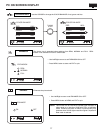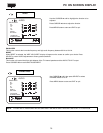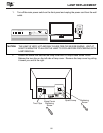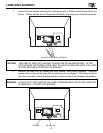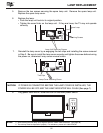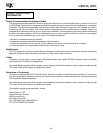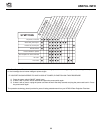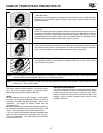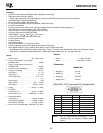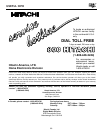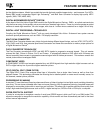
90
DEMAN
MOI!
FEATURE INFORMATION
As the digital era dawns, Hitachi has models that provide the best possible images today....and tomorrow. Our HDTV-
Ready DMX model incorporates Digital Light Processing
TM
and Multi Scan Converter to display high quality HDTV
signals (1080i, 720P, 480P, 480i).
DIGITAL MICROMIRROR DEVICE
TM
SYSTEM
At the heart of the Ultra Vision Digital DMX model is the Digital Micromirror Device
TM
. DMD
TM
, an optical semiconductor
chip that has an array of microscopic mirrors mounted on a standard logic device. These tiny mirrors operate as optical
switches to create high resolution, full color images, with close to 1 million mirrors contained on a single 0.8 inch chip.
DIGITAL LIGHT PROCESSING
TM
TECHNOLOGY
Coupling the Digital Micromirror Device
TM
with our newly developed Ultra Vision 10-element lens system ensures
maximum picture performance, such as 1280 x 720 display resolution.
MULTI SCAN CONVERTER
The Multi Scan Converter detects many kinds of signals having different signal timings, such as, NTSC, SDTV, HDTV,
VGA, SVGA, and XGA, then executes pixel format conversion and frame rate conversion to make a proper picture for
a Digital Micromirror Device
TM
.
FLEX CONVERTER TECHNOLOGY
The Flex Converter converts both NTSC and 480i SDTV signals to progressive scanned signals. This unit creates
pictures like Split, Picture in Picture, Surf 3 and Freeze. It automatically detects a DVD movie with 24 frames per
second recorded, then converts to progressive scanned signal with 60 frames per second. This makes a smooth and
natural picture without overlapped fields.
COMPONENT VIDEO
A COMPONENT VIDEO input accepts separate blue, red & B/W signals from high resolution digital sources such as
DVD or digital set-top box to provide a higher resolution picture.
3DYC (DIGITAL 3DYC COMB FILTER)
The Digital 3DYC Comb Filter analyzes three lines of information from a single video frame as well as lines from
adjacent frames. This technology eliminates the flickering that a detailed pattern or scene would normally cause, for
the cleanest, neatest picture possible.
PROGRESSIVE SCANNING
A standard TV uses Interlaced Scanning where each frame of video is broken into two fields, each providing alternating
scan lines. This can leave noticeable scan lines and cause flickering. With Progressive Scanning, complete frames are
displayed for a smoother picture with no scan lines and no flicker. This allows you to get the optimal picture quality from
today’s high resolution digital sources such as DVD, a digital set-top box, SVGA or with a VGA input, a computer.
DDC2B PROTOCOL SUPPORT
In order for a computer to recognize a monitor it must have DDC2B support, which you’ll find in our DMX model. This
allows the computer to recognize the resolution capability of that monitor and then automatically set itself to that level
without manual adjustments.



